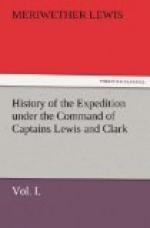August 28. The purchase of horses was resumed, and our stock raised to twenty-two. Having now crossed more than once the country which separates the head waters of the Missouri from those of the Columbia, we can designate the easiest and most expeditious route for a portage; it is as follows:
From the forks of the river north 60 degrees west, five miles to the point of a hill on the right: then south 80 degrees west, ten miles to a spot where the creek is ten miles wide, and the highlands approach within two hundred yards; southwest five miles to a narrow part of the bottom; then turning south 70 degrees west, two miles to a creek on the right: thence south 80 degrees west, three miles to a rocky point opposite to a thicket of pines on the left; from that place west, three miles to the gap where is the fountain of the Missouri: on leaving this fountain south 80 degrees west, six miles across the dividing ridge, to a run from the right passing several small streams north 80 degrees west, four miles over hilly ground to the east fork of Lewis’s river, which is here forty yards wide.
Thursday 29. Captain Clarke joined us this morning, and we continued our bargains for horses. The late misfortunes of the Shoshonees make the price higher than common, so that one horse cost a pistol, one hundred balls, some powder and a knife; another was changed for a musket, and in this way we obtained twenty-nine. The horses themselves are young and vigorous, but they are very poor, and most of them have sore backs in consequence of the roughness of the Shoshonee saddle. We are therefore afraid of loading them too heavily and are anxious to obtain one at least for each man to carry the baggage, or the man himself, or in the last resource to serve as food; but with all our exertions we could not provide all our men with horses. We have, however, been fortunate in obtaining for the last three days a sufficient supply of flesh, our hunters having killed two or three deer every day.
Friday 30. The weather was fine, and having now made all our purchases, we loaded our horses, and prepared to start. The greater part of the band who had delayed their journey on our account, were also ready to depart. We then took our leave of the Shoshonees, who set out on their visit to the Missouri at the same time that we accompanied by the old guide, his four sons, and another Indian, began the descent of the river, along the same road which captain Clarke had previously pursued. After riding twelve miles we encamped on the south bank of the river, and as the hunters had brought in three deer early in the morning we did not feel the want of provisions.




